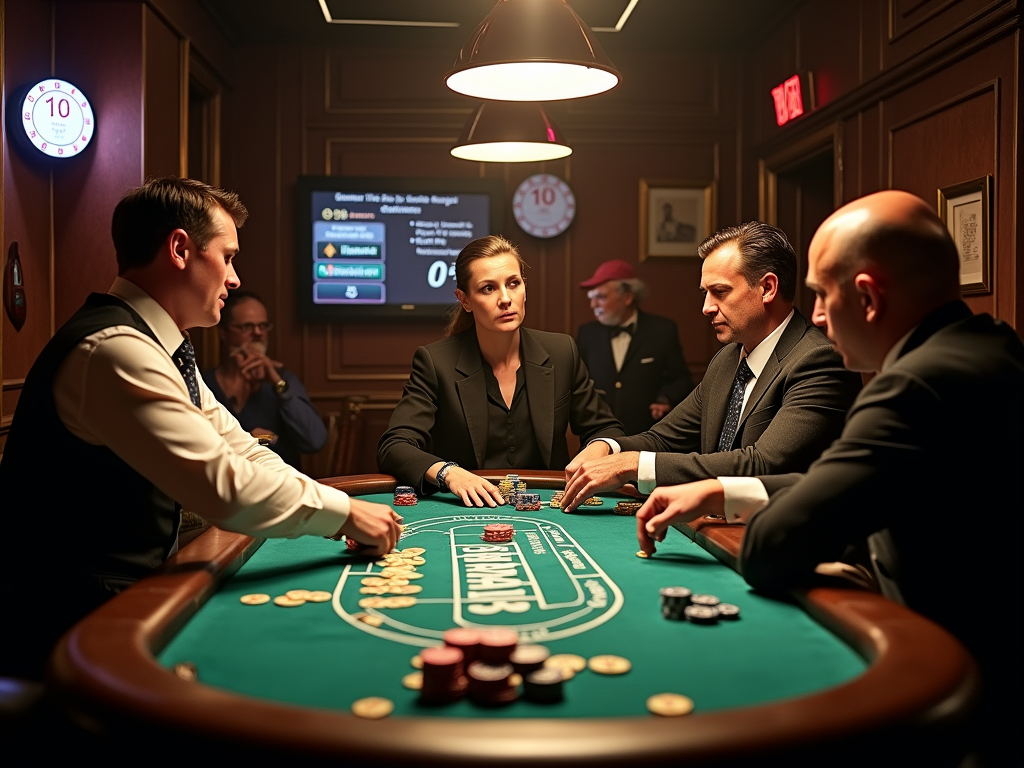Mastering Blackjack: Strategy, Math, and Winning Potential
Blackjack stands as a precise blend of math and strategy, giving players exceptional winning potential through skilled gameplay. This classic card game has transformed from its French “Vingt-et-Un” roots into a modern casino staple where smart decisions directly affect success rates.
Key Takeaways
- The fundamental goal is to beat the dealer’s hand without exceeding 21, with most casinos using 6–8 decks.
- Basic strategy reduces the house edge to approximately 0.5% or lower when followed correctly.
- Choose tables with 3:2 payouts for natural blackjacks instead of less favorable 6:5.
- Smart bankroll management requires 50–100 times your average bet for each session.
- Essential moves like splitting Aces and 8s, plus doubling down on 11 create the basis for profitable play.
I emphasize these proven techniques because they’ve consistently demonstrated success at tables worldwide. The game’s appeal lies in its clear objectives mixed with strategic depth. Each decision point offers opportunities to apply calculated moves that improve winning chances.
Why Basic Strategy Matters
Players who master basic strategy gain a significant advantage. This knowledge transforms casual gambling into strategic gameplay. The house edge shrinks considerably through proper play, making blackjack an attractive option for serious players.
Sustainable Play Through Discipline
Consistent practice and disciplined betting strengthen these fundamentals. I focus on maintaining strict bankroll limits while maximizing opportunities during favorable situations. This balanced approach supports long-term success at the blackjack table.
The Art and Science of Blackjack: From Basics to Victory
Rich History and Evolution
I can trace Blackjack’s fascinating roots back to the glittering salons of 18th-century France, where it started as “Vingt-et-Un” (Twenty-One). This elegant card game made its way across the Atlantic, transforming into what we now know as Blackjack in American casinos. What’s particularly interesting is how casinos initially offered a special 10:1 bonus payout for a natural blackjack featuring the Ace of Spades paired with either the Jack of Spades or Clubs — a promotion that helped cement the game’s current name.
Modern Game Structure
Today’s Blackjack bears both similarities and differences to its French ancestor. The fundamental goal remains straightforward — beat the dealer’s hand without going over 21. I’ve seen the game played with varying deck counts, from single deck games to the more common 6–8 deck variations you’ll find in most casinos.
Here’s what you need to know about modern Blackjack’s core structure:
- Players must place their bets before receiving any cards
- Each player gets two cards face-up, while the dealer takes one card face-up and one face-down
- Face cards (Jack, Queen, King) are worth 10 points
- Aces can count as 1 or 11, depending on what helps your hand
- Numbered cards maintain their face value
The dealer must follow strict rules about hitting or standing. In most casinos, dealers must hit on 16 or below and stand on 17 or above. This predictability creates opportunities for strategic play, making Blackjack unique among casino games. I’d recommend checking out our complete guide to casino card games for more insights into game variations.
Unlike other casino games, Blackjack combines luck with genuine skill. Your decisions directly impact the outcome, and learning proper strategy can significantly reduce the house edge. For those interested in advanced betting techniques, I’ve found that understanding various betting systems can enhance your overall gaming experience.
Essential Playing Decisions That Win Games
Core Gameplay Actions
Making the right decisions at the blackjack table can dramatically improve your winning chances. Let me break down the fundamental moves you’ll need to master.
Hitting draws another card from the deck when you want to improve your hand total. I recommend hitting on any hand totaling 8 or less, as there’s no risk of busting. You’ll also typically want to hit on totals of 12-16 when the dealer shows a 7 or higher.
Standing keeps your current cards without drawing more. This move makes sense when you have a strong hand like 17-20 or when the dealer shows a weak upcard (4-6). The goal is letting the dealer bust while protecting your solid position.
Doubling down is a powerful move where you double your initial bet and receive exactly one more card. I suggest doubling on 11 almost always, and on 10 when the dealer shows 9 or lower. With soft hands (those containing an Ace), doubling on soft 13-17 against dealer’s weak cards can be profitable.
Splitting pairs creates two separate hands by matching your original bet. Here are the key pairs you should always split:
- Aces and 8s (always split these)
- 2s and 3s against dealer’s 4-7
- 6s against dealer’s 3-6
- 7s against dealer’s 2-7
Advanced Strategy Elements
Card values form the foundation of all strategic decisions. While number cards keep their face value, face cards (Jack, Queen, King) count as 10. The Ace’s flexible 1 or 11 value creates interesting strategic opportunities, especially in soft hands.
Double After Split (DAS) lets you double down after splitting pairs. This valuable option increases your potential profit, particularly with split Aces or 8s facing a dealer’s weak card.
Surrender might seem like admitting defeat, but it’s actually a smart defensive move in specific situations. By giving up half your bet and ending the hand immediately, you’ll lose less money long-term than playing out poor hands. I recommend surrendering 16 against dealer’s 9, 10, or Ace, and 15 against dealer’s 10.
Understanding the difference between hard and soft hands shapes your entire strategy. A soft hand contains an Ace counted as 11, giving you flexibility to hit without busting since the Ace can switch to 1. Hard hands lack this safety net, requiring more cautious play.
Want to dive deeper into winning strategies? Check out my complete guide to casino card games for more advanced techniques. You’ll also find valuable insights in my article about proven betting systems and strategies that can boost your success at the tables.
Master Basic Strategy for Consistent Wins
Basic strategy in blackjack isn’t just about following hunches – it’s backed by solid math and proven results. I’ve found that using these fundamental plays can slash the house edge to roughly 0.5% or lower, making blackjack one of the most player-friendly casino games. Let me break down the key moves that’ll boost your chances of winning.
Essential Basic Strategy Moves
Before diving into specific plays, it’s important to understand what makes these moves so effective. These decisions are based on millions of computer simulations that show the mathematically best play for every possible hand combination.
Here are the core moves you need to memorize:
- Stand when you have a hard total of 17 or higher – this protects your hand from busting
- Keep your hard 13-16 against dealer’s 2-6 – let the dealer take the risk of busting
- Hit your hard 12 when facing dealer’s 2-3 – the odds favor drawing another card
- Double down on hard 11 against dealer’s 2-10 – maximize profit on this strong starting hand
- Always split Aces and 8s – these pairs work better as separate hands
- Never split 5s or 10s – they’re more valuable as single hands
Like learning the fundamentals of baccarat, mastering these basic blackjack plays takes practice. But once you’ve got them down, they’ll become second nature at the table.
I recommend starting with these core moves before moving on to more advanced plays. Similar to how betting systems can enhance your gameplay, following basic strategy gives you a solid foundation for success.
The beauty of basic strategy is its simplicity – there’s no counting cards or complex systems to learn. Just straightforward, mathematically-proven decisions that work time and time again. By sticking to these plays, you’ll avoid common mistakes that cost players money and give yourself the best chance to walk away a winner.

Smart Game Selection and Bankroll Management
Finding the Best Blackjack Tables
I always prioritize tables offering 3:2 payouts for natural blackjacks instead of the inferior 6:5 payouts. This single rule difference creates a substantial 1.39% swing in the house edge – money that stays in your pocket rather than the casino’s. When scouting for optimal playing conditions, I target tables where dealers must stand on soft 17 (S17) rather than hit (H17), giving players a 0.22% better chance of winning.
Here’s what I check before sitting down at any blackjack table:
- Number of decks in play – fewer decks mean better odds for players
- Double After Split (DAS) – this valuable option improves your strategic possibilities
- Surrender availability – being able to forfeit half your bet can save money in tough spots
- Dealer hitting or standing on soft 17
- Natural blackjack payout ratio (3:2 vs 6:5)
Managing Your Money Like a Pro
Smart bankroll management makes the difference between casual players and serious contenders. Through my experience with casino table games and betting strategies, I’ve learned that setting aside a specific gambling bankroll is crucial.
I recommend bringing 50–100 times your average bet to each session. This gives you enough cushion to weather the inevitable swings while playing optimal strategy. For example, if you’re betting $20 per hand, bring $1,000–$2,000 as your total bankroll.
For consistent results, limit each bet to 1–2% of your total gambling funds. This measured approach helps protect against devastating losses while keeping you in action long enough to see positive variance work in your favor. I also set strict loss limits per session – typically 20–25% of the bankroll I brought to the table.
Just as important as knowing when to stop losing is having a target win goal. Once I hit my predetermined profit target (often 50% of my buy-in), I either end my session or continue playing with just my winnings. This disciplined betting approach helps lock in profits instead of giving them back to the house.
The combination of selecting games with player-friendly rules and maintaining strict bankroll discipline creates the foundation for long-term success at blackjack. By following these guidelines, you’ll maximize your chances of walking away a winner while minimizing the risk of catastrophic losses.

Common Mistakes That Cost Players Money
I’ve watched countless players throw away money at the blackjack tables by making avoidable mistakes. Let me share the most costly errors I see and how to dodge them.
Strategy and Betting Blunders
Going with your gut instead of using proven basic strategy decisions is a fast track to losing money. Basic strategy isn’t just a suggestion – it’s mathematically proven to give you the best chances of winning.
Taking insurance bets is one of the biggest traps in blackjack. The house edge on insurance bets climbs above 7%, making it one of the worst bets you can make. Skip it every time, even when the dealer shows an ace.
Many players try to copy the dealer’s strategy of hitting until they reach 17. This approach ignores the key advantage players have – the ability to play hands differently based on the dealer’s upcard. Using proper betting systems and strategies makes a huge difference in your results.
Here are the most expensive mistakes I regularly spot at the tables:
- Splitting 10s: Your 20 is already a powerful hand – don’t break it up hoping for something better
- Not splitting 8s: Always split 8s against a dealer’s 2-7, it improves your chances significantly
- Playing without checking table rules: Different tables have varying rules that affect your odds
- Poor bankroll management: Not setting loss limits or chasing losses leads to bigger problems
- Increasing bets after losses: This common reaction typically leads to even bigger losses
I’ve noticed many players don’t take time to check the specific rules at their table before sitting down to play. Rules like dealer hitting on soft 17, restricted doubling down options, or fewer deck penetration can significantly impact your expected return. Always verify the rules and adjust your strategy accordingly.
Proper bankroll management often gets overlooked in the excitement of the game. Set clear limits for both wins and losses before you start playing. When you hit either limit, stick to your plan and walk away. This discipline helps protect your bankroll and keeps the game enjoyable.
Remember, blackjack isn’t about random hunches or feeling lucky. It’s a game of skill where mathematical probabilities should guide your decisions. By avoiding these common mistakes and sticking to proven strategies, you’ll maximize your chances of walking away a winner.

Advanced Techniques for Serious Players
Card counting isn’t just about keeping track of numbers – it’s a sophisticated approach that can give skilled players a mathematical edge. The Hi-Lo system serves as an excellent entry point into advantage play, assigning values of +1 to low cards (2-6), 0 to neutral cards (7-9), and -1 to high cards (10-Ace).
Mastering the Count
I’ve found that successful counting requires maintaining both a running count and converting it to a true count. The running count tracks the flow of cards, while the true count accounts for remaining decks. To convert, simply divide the running count by the number of decks left in play. For example, a running count of +8 with 2 decks remaining yields a true count of +4.
Here’s what experienced players monitor during a counting session:
- Deck penetration depth – ideally 75% or deeper for maximum effectiveness
- True count thresholds for bet sizing adjustments
- Deviations from basic strategy based on count
- Position of other players’ discards for ace tracking
- Shuffle tracking opportunities during multi-deck games
Betting correlation directly ties to the count – as the true count increases, so should your bets. A general rule is to increase your base bet by one unit for each positive true count point. However, proper bankroll management remains crucial for long-term success.
Shuffle tracking and ace sequencing take counting to another level. By tracking clumps of high-value cards through the shuffle, skilled players can predict rich sections of the deck. This technique requires intense concentration and detailed observation of dealer patterns and shuffling procedures.
While card counting isn’t illegal, casinos actively prevent it through various countermeasures. They’ll use continuous shuffling machines, restrict mid-shoe entry, and watch for betting pattern variations. Some properties even employ facial recognition to identify known advantage players.
Deck penetration dramatically impacts potential advantage. Deep penetration of 75% or more provides more reliable count information and better opportunities for profit. Shallow penetration of 50% or less significantly reduces counting effectiveness. I recommend seeking games with favorable penetration and implementing proper betting strategies based on true count calculations.
Remember, these advanced techniques require substantial practice away from the tables. Perfect your skills through simulation before risking real money. The combination of proper counting, tracking, and betting correlation creates opportunities for skilled players to gain an advantage in blackjack.
Sources:
wizardofodds.com
blackjackapprenticeship.com
Beat the Dealer by Edward O. Thorp
Professional Blackjack by Stanford Wong
American Mensa Guide to Casino Gambling by Andrew Brisman





